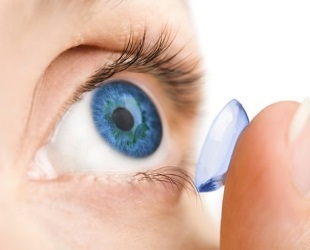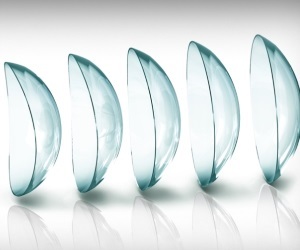
Thanks to the night lenses anyone can easily restore their eyesight.
It is enough to put on the lenses for the night and already in the morning you will see the world clearly, clearly.
Now any person with myopia, astigmatism, hyperopia can improve their vision without a laser, glasses and wearing daytime lenses.
Relax on the nature, swim, walk on the mountain slopes or give children a bright childhood without a rim around the eyes. This is real, because there are nighttime contact lenses( CL).
Do you want to recover sharp eyesight without surgery and wearing glasses? You definitely need nocturnal lenses. If you follow the rules of hygiene and take care of the health of your eyes, orthokeratological lenses( OKL) will be a reliable friend and will present a clear visual picture for the whole day.
- 1. Description of method
- 2. Target group of orthokeratology and to whom it is contraindicated
- 3. Qualitative characteristics of
- method 4. Cost of
- 5. Practical aspects of
- 6. Testimonials of
- 7. Conclusion
Description of method
Historyappearance
They say that in ancient times, the Chinese slept with weights and bags on the eyelids to get rid of myopia. The principle is similar to today's correction of vision by night CR.About a century ago, the eye doctor Eugene Cal wanted to change the curvature of the cornea with the help of KL, pressing on the cone.
Until the corneal lenses were invented, the possibility of changing the shape of the cornea with the help of CR was not recognized.
When, in the middle of the last century, corneal appeared, experts noticed that people had a curvature of the cornea. Those who had lenses for more than two years did not find the progress of myopia. The change in curvature stimulated the improvement of well-being in myopia by flattening the cornea of the CR.
George Jessen, the father of orthokeratology, in 1962 informed the society about his technique "orthofocus".Instead of choosing lenses, Jessen chose simple ones with zero refraction. They were selected based on the magnitude of myopia. Jessen found out that after the removal of the cornea, the cornea is flat. Vision improves. The same principle is used for hypermetropia.
Specialist suggested the idea of creating a lens with an inverse geometry, a flat center. But in those days the technique could not produce such lenses. By the mid-80s of the last century, enthusiasts Tubb, Nolan, May, Grant, Neilson, Siff developed the technique of "orthokeratology."
Scientist Cairns was the first to conduct a comparative study of daylight and OKL.In 1983, Pouls and colleagues published the results of the study( in Berkeley) found that, despite the limited effect( temporary improvement in vision), OKL is safe for health. Next, the scientist Kun took up the study. And perfection continued. Modern orthokeratology began with the appearance of OKL, authored by Thomas Reim. It had a back surface with centering curvature, an alignment zone.
This allowed better centering of the CL, getting a good result right away. After a while, the researchers got good results no longer in a few weeks or months, but a couple of days after the first application. Night wearing gave a more accurate result. At night, CL is immobile, so it effectively affects the cornea. Further the design only improved. At the turn of the millennium, there were designs from farsightedness and astigmatism.
In 2002, the scientists held a whole symposium on orthokeratology, which was attended by representatives of 29 countries. Today, night orthokeratology has become increasingly popular. This is a new direction in correcting vision problems.
In the 40s of the last century, scientists found that scleral give the effect of "shaping" the cornea. A similar fact was accidentally noted when flat lenses were mistakenly assigned. It turned out that vision remains good even after the person removed the KL.And all because the optical power of the cornea changes.
Complexities with centralization prevented the development of the method. But in the 90's they developed a CR with an inverse geometry. This discovery was a revolution. And OKL got the necessary center.
The essence of the method and who uses it
Orthokeratology refers to the modern method of correcting astigmatism and nearsightedness for a certain time. It uses rigid gas-permeable contact lenses( they are called night lenses, OK lenses).
They are used during sleep. Programmed reorganization of the corneal epithelium increases visual acuity.
This progressive method serves as an alternative to glasses or refractive surgery. It is also relevant for those who do not want to wear contact lenses during the day. This is due to the presence of discomfort from the lens when in a dusty or air-conditioned room, as well as in the process of working in front of the monitor or participating in sporting events.
Features of the effect of
The mechanism of correction of myopia by the method of orthokeratology is the redistribution of epithelial cells in the cornea under the influence of OK-lens. After putting on the night lenses, during the sleep, a gradual change in the shape of the cornea occurs. Its middle( optical zone) becomes more flat. Read more - symptoms of Sjogren's syndrome. How to recognize this disease?
In the news( tyts) the nature of people with chameleon eyes.
How to get eye heterochromia?http: //moezrenie.com/simptomy/ geterokhromiya-glaz.html
This process is not accompanied by a violation of the anatomy and integrity of the corneal layers. Changes in 10-30 microns are very small, so they can detect only a special device - keratotopograph.
Despite the insignificance of the changes, they are sufficient for a good vision in the daytime without the use of contact lenses or glasses. When a person removes nocturnal lenses, a new shape of the cornea is preserved. The retina is focused on the image, the vision becomes good.

The former form of the cornea recovers slowly. As a result, quality vision remains at least until the next dream. Often it "suffices" for two days.
About the results of using orthokeratology patients respond in their records. They are given in the final part of the article.
Advantages of Orthokeratology in front of glasses and conventional lenses
If you choose night KL instead of glasses or traditional daytime contact, then the person will receive complete freedom of action.
Formerly limited the frame, and you could not perform some actions, becausewear glasses? Or did you have difficulty with swimming, because you do not see much under water? Now these and similar restrictions will remain in the past.
- The eye cornea will receive the right amount of oxygen in the daytime, becauseDuring the day, a person will not apply any methods to correct vision.
- You will get protection from various diseases that people have when wearing daytime.
- The likelihood of dry eye syndrome, compared with daytime, will be extremely small. If a person wears OKL, then he does not have "dry eye syndrome".
- Live free. So, like you have sharp eyesight. Do not limit yourself and forget that your eyes do not see as you would like. Night will give such a luxury.
- Women can freely paint their eyes as they wish. After all, now they do not need to think about what cosmetics to choose, so that it looked good with glasses or did not cause allergies, did not flow into the eyes and did not fall into the KL.
- Now there is no irritation from the fact that a piece of cosmetics has got into the eye. Do not have to remove the lens and wear protective goggles for swimming.
You can wear night lenses even to children from 6 years old.
Task group of orthokeratology and to whom it is contraindicated
In what cases is the method
OK-lenses used for:
- Patients of the age group 7-40 years with astigmatism up to 1.5 diopters and nearsightedness up to 6. These figures are relative as possibleexcellent result and with greater myopia.
- Adolescents and children with progressive myopia.
- Adult patients with myopia, who are contraindicated in refractive surgery for various reasons.
- Adult patients with nearsightedness, who are inconvenient to wear contact lenses and glasses due to the profession - athletes, pilots, military, drivers, as well as working in dusty or smoky rooms( builders, bartenders, waiters), etc.
To whom it is contraindicated
The method of orthokeratology is contraindicated in persons suffering from:
- inflammatory diseases of the conjunctiva and cornea( keratitis, conjunctivitis),
- keratoconus and keratoglobus,
- dry eye syndrome,
- lagophthalmic,
- severe upper eyelid rigidity,
- chronic inflammatory diseases of the eyelids( blepharitis, haljazionami, meibomites),
- corneal astigmatism above 1.75D.
Qualitative characteristics of the method
Convenience and safety

Both adults and children note exceptional comfort during sleep in OK lenses. If you use them with your eyes open, then at first you may feel the presence of an alien body.
This is due to the specific design of the edge of the night lenses and blinking movements. Since these movements are absent in a dream, there is no discomfort. Gradually, the eyes get used to these lenses and in the open state, although they are intended only for sleeping.
There is a high safety of this method of visual correction. At the moment, there is no information about the significant problems caused by wearing night lenses.
Possible complications of
At the beginning of the orthokeratology method, complications arose due to hypoxia of the cornea( oxygen starvation).Today, this drawback is eliminated through the use of high-permeability materials, from which lenses are made.
Another complication concerns microbial keratitis - inflammation of the cornea. It is accompanied by a decrease in visual acuity. It is important to note that any keratitis in contact correction is most often caused by gross violation of important rules by patients in the form of:
- using OK lenses in a painful condition,
- failing to undergo a follow-up inspection,
- alone increasing lens use time,
- violation of lens processing rules and t.
Price

The first selection of night lenses will require quite high costs. The average price of lens selection in the medical center is about 15 thousand rubles.(including the price of the lenses themselves).Given the considerable period of their service, the monthly cost of correction is about 1 thousand rubles.
But each next pair will be cheaper. This is due to a simpler selection that does not require expensive special surveys( they have already been passed for the first time).
In the future, night lenses can be bought on proven sites dedicated to healthy eyesight and choice of medical optics. And their cost can be quite low - 700-1000 rubles.
Practical aspects of
The OK-lens should be selected by a highly qualified doctor. As a rule, you first need two pairs of lenses to six. Careful selection procedure lasts up to two weeks. The last pair of lenses are prescribed for systematic wearing.
The service life of night lenses is quite long. With competent care, it is at least two years. To look after such lenses is more economical and easier, than for soft ones. They are more difficult to break, they are not prone to drying out.
Lenses are worn for the night, removed in the morning. To analyze the condition of the eyes and lenses, it is required to consult a doctor every 6 months. It is better to do this more often.

Note - the causes of myopia. Why is myopia developing?
The article( link) effects the wearing of contact lenses.
Price for eye drops Levomycetin!httpd: //moezrenie.com/lechenie/ kapli-dlya-glaz / levomitsetin-glaznoi.html
In addition to regular examinations, it is necessary to observe the prescriptions:
- daily eye care and lenses,
- regular lens cleaning with specialists,
- timely replacement of lenses in the process of eye growth of children.
Customer Reviews
Night lenses are worn by adults, but also this method of correction is popular among children. The reason is simple: orthokeratology quickly restores vision and is safe for health. Due to the fact that they can be worn by children from 6 years old, parents are increasingly choosing this option of vision correction.
Few kids want to wear glasses. Therefore, parents have to look for a compromise. Daytime contact is not suitable for children who lead an active lifestyle. Do not deprive children of their childhood? For this reason, parents buy babies and in 99% of cases everyone is happy with the result: both children and parents.
Reviews of night lenses are positive. But parents often fear for the health of the baby's cornea, because it is necessary to ensure proper care and hygiene. Doctors calmed: it is necessary to teach the child to use KL and everything will be fine.
Teenagers like these KL very much, becauseno one likes glasses or foreign objects in the eyes throughout the day. Therefore, parents are increasingly buying orthokeratology for schoolchildren.
Adults are also happy with the result. Acute vision persists the whole day, and sometimes more. However, sometimes there are reviews that the cost of OKL "bites".But, if we compare their price with the result, it becomes clear: the result is worth the effort.
Examples of

# 1. My daughter is 12.5 years old. She wears night lenses for the fifth year. From grade 2 she had a worse vision. Many specialists have passed. Finally, they ventured and turned to orthokeratology.
In any case, myopia does not increase. It seems to me that today this is the most effective method of correction. Only I'm afraid of distant negative consequences with respect to the cornea.
# 2. Three years my son uses night lenses. Now he is 15 years old. At it or him since 7 years vision worsened. We reached the Center for Eye Microsurgery. Applied hardware treatment, massage, gymnastics for the eyes, vitamins. Not much sense. At the age of 12, I began to put on my lenses for the night.
I very much doubted, but still took the risk. So far there are no regrets. In the afternoon he has excellent eyesight, even swims and plays football. To put on for the night and remove in the morning - not a problem. Vision does not deteriorate. We go to the inspection regularly.
Conclusion
Correcting visual defects with OK lenses is a good alternative( and sometimes the only) laser correction and wearing contact lenses or glasses. And this despite the costly procedure of their selection and acquisition. In the future, the cost will decrease, and the range of correction will expand. This will affect the increase in the popularity of orthokeratology.
